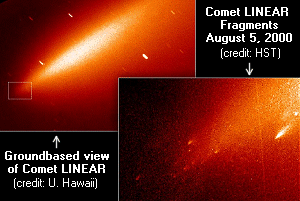
By now you may be wondering when you might get a chance to observe a comet yourself. Astronomers now track the locations of many comets, and tell the public when a comet may be visible, and where it will appear in the sky. New comets are also being discovered all the time with today's powerful telescopes and satellites. When this happens the scientists name the comet, predict its path, and how bright it may be.
|
Summer, 2000: Comet Linear and its amazing story! In the summer of 2000, a comet named Linear was discovered as it approached the earth and sun. For a short time it was visible at night with binoculars. Then Comet Linear violently broke apart around July 26, 2000, when it made its closest approach to the sun, leaving many smaller mini comets instead of one large comet. |
Comet Linear moving across the sky (repeating animation).
www.astrophotographer.com |
|
(credit:STScI-PR00-26 July 28, 2000 press release) |
At first Comet LINEAR had one large
nucleus. Then, in a three day sequence of
events the comet
became twice as bright and a chunk of it blew off like a
cork from a bottle. Later, the nucleus broke into many
fragments. These smaller pieces of Linear continued traveling in
the same direction, like bright trails of fireworks. |
| Though comets have been known to break apart before (in 1994 Comet Shoemaker-Levy 9 broke up before it struck Jupiter), this is the first time scientists have had a view of this from so close-up. |  |
Fall 2000: A newly discovered comet!
On October 7th, 1999, astronomers discovered that a new comet is coming and it was named Comet McNaught-Hartley (after the two people who discovered it). Scientists are studying this distant comet, and according to their predictions, Comet McNaught-Hartley is expected to be brightest in December 2000 or January, 2001.
Beyond 2000: Will we see other comets in the future?
Yes! Astronomers know that Comet Encke (EN-key), which has been studied for many years, will be flying by in the year 2003. This is its 59th known visit to the solar system. Comet Encke returns every 3.3 years, but it is not visible from Earth every time. In the year 2003 it will return and be visible. So, join the comet party and mark it on your calendar! Other new comets are being discovered every year.
![]()
1145 1300 1402 1587 1680 1858 1900 2000
©Copyright 2000 Regents of the University of California.

